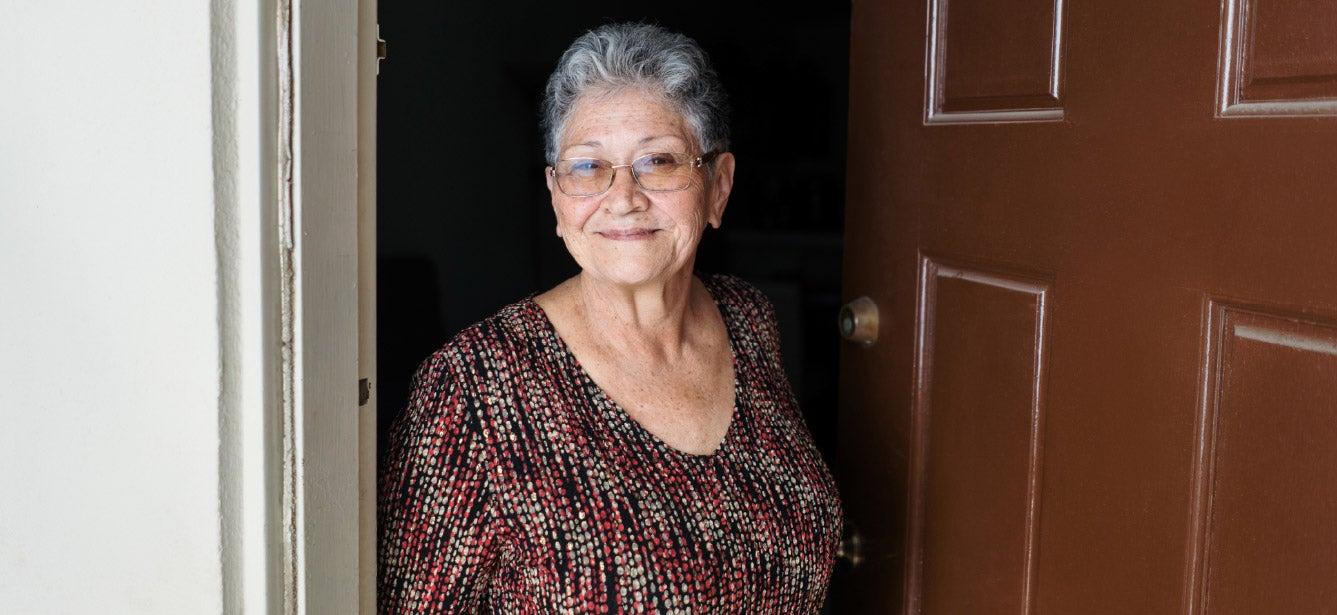
What does it mean to be “cost burdened”—a term that describes more than 10 million American households headed by someone age 65+? It means spending more than a third of your income on housing (a standard benchmark of housing affordability). Homeowners and renters who are cost burdened have less money to spend on necessities like health care and food compared to those with more economic stability. Too often, they’re forced to choose between paying rent and getting medical care or buying groceries.
“Housing prices still have not come down to pre-pandemic levels,” explains Shaneece Gaines, Program Manager of Economic & Financial Security at NCOA. “High rents and rising property taxes continue to cause financial hardship for millions of older adults with low income, particularly for people of color.”
Fortunately, there are subsidized senior housing options for those with limited financial means. One of these is the Section 8 Housing Choice Voucher Program from the U.S. Department of Housing and Urban Development (HUD), commonly known as “Section 8 housing.”
What is Section 8 housing?
Funded by the federal government, the Section 8 Housing Choice Voucher Program helps older adults, people with disabilities, and families with low income find affordable, decent private housing. Its goal is to provide these groups with access to better living conditions and an improved quality of life.
Under the Section 8 program, eligible participants receive a voucher that covers a portion of their monthly rent. A voucher functions much like a coupon; it’s a document that can be used in place of money to pay for something. Housing choice vouchers are issued and managed at the local level by public housing authorities (also called public housing agencies/PHAs).
Approved Section 8 participants have choices in where they can live. They may choose from privately owned single-family homes, townhouses, and apartments. The property owner or landlord must agree to rent them a unit under the Section 8 program. HUD also requires that Section 8 homes be thoroughly inspected to make sure they meet safety standards.
What is the Section 8 voucher amount?
The level of rent assistance a household receives is based on their income and the local rental market. Renters must pay 30% of their monthly adjusted gross income (AGI) for rent and utilities. AGI is the amount of income earned before any deductions. If the monthly rent exceeds that amount, the renter must pay the difference. However, they cannot apply more than 40% of their AGI toward rent.
What are the Section 8 housing income limits?
Section 8 housing requirements cover areas such as financial need, citizenship status, and household makeup. In general, applicants must:
- Have very low or low income that does not exceed 50-80% of the median income for the region where applicants want to live (additional criteria must also be met)
- Have U.S. citizenship or eligible immigration status
- Fit HUD’s definition of a family (this can include single people)
In most cases, applicants must also live within the jurisdiction of the housing authority to be eligible for housing vouchers in that area.
Your local housing authority can tell you the Section 8 income limits for your county (visit the HUD website and select your state to see a list of housing agencies near you). You can also learn more about Section 8 housing eligibility by reading the Housing Choice Voucher Guidebook.
Where can I get a Section 8 application?
If you’re interested in applying for Section 8 housing assistance, you must contact your area housing authority. Depending on where you live, your Section 8 application can be completed online or by filling out a paper form. It costs nothing to apply.
The application will ask you to provide specific information for all household members, which may include (but is not necessarily limited to):
- Name, date of birth, and Social Security number
- Proof of U.S. citizenship or legal immigration status
- Proof of current residence
- Proof of income from all sources (e.g., pay stubs or tax forms)
- Landlord references
Since the program focuses on providing safe housing, the Section 8 application process also requires all adult applicants to undergo a criminal background check. It's important to fill out your application as thoroughly as possible to avoid any delays in processing.
Housing assistance is in demand, and this demand often exceeds the available Section 8 funding in many areas. As a result, long waiting periods for Section 8 housing are not uncommon. If you’re found to be eligible for subsidized senior housing but no vouchers are available, you will be put on a waitlist. Once your name comes up on the list, your housing authority will contact you and provide you with a housing voucher. Housing authorities have the right to prioritize certain waitlisted families, such as those who are homeless or living in unsafe or unsanitary housing conditions.
What is the difference between the Section 8 and Section 202 programs?
Like the Section 202 Supportive Housing for the Elderly program, the Section 8 housing program is designed for people with low income. It serves not only older adults, but also people with disabilities and families. However, Section 202 is more specific in who it benefits. This program was specially created to help households with older adults (age 62+) access affordable dwellings. Additionally, Section 8 participants have their choice of housing options, while Section 202 participants are limited to specific approved properties.
“Older adults today want and deserve to be able to age in place,” says Gaines. “But to do so, they need to have housing that’s safe, comfortable, and reasonably priced. Housing assistance programs like Section 8 play a major role in helping older Americans stay in their homes for as long as possible.”
Learn more about senior housing assistance
Get additional details about the Section 8 Housing Choice Voucher Program —including how to apply—with NCOA's online tool. BenefitsCheckUp® connects millions of older adults and people with disabilities with benefits programs that can help them worry less and age better.
How can you take part? Just visit BenefitsCheckUp.org and enter your ZIP code. While you’re there, browse other money-saving programs that can help you pay for medications, food, transportation, and more.




